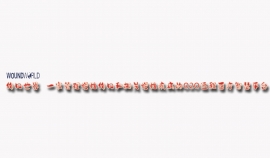文献精选
Jonathan Johnson1 · Alton R. Johnson Jr.2 · Charles A. Andersen3 · Martha R. Kelso4 · Alisha R. Oropallo5 · Thomas E. Serena6 iD
Received: 4 November 2022 / Revised: 22 March 2023 / Accepted: 31 March 2023
© The Author(s) 2023
Abstract
Underrepresentation of diverse skin tones in medical education and providers’ implicit racial bias drives inequities in wound care, such as disproportionally poor outcomes for Black patients. Diagnostic indicators (e.g., erythema) can present differently depending on skin pigmentation. This post hoc analysis of 350 chronic wounds from a prospective 14-site clinical trial aimed to determine how the perception of clinical signs and symptoms of infection (CSS) differs by patient skin tone and if fluorescence-imaging can offer a more objective diagnostic solution. Participants were grouped by skin tone (low,
medium, high) as measured by the Fitzpatrick Skin Phototype Classification (FSPC) scale. CSS and total bacterial load
(TBL) were compared across FSPC groups, along with sensitivity to detect TBL >104 CFU/g using CSS alone and combined
with fluorescence-imaging. Erythema was reported less often with increasing FSPC score (p = 0.05), from 13.4% (low),
to 7.2% (medium), to 2.3% (high), despite comparable bacterial loads (median = 1.8 × 106 CFU/g). CSS sensitivity in the
high group (2.9%) was 4.8-fold to 8.4-fold lower than the low (p = 0.003) and medium groups (p = 0.04). Fluorescenceimaging significantly improved the detection of high bacterial load in each group, peaking in the high group at 12-fold
over CSS alone. These findings underscore the threat of pervasive racialized health inequities in wound care, where missed
diagnosis of pathogenic bacteria and infection could delay treatment, increasing the risk of complications and poor outcomes.
Fluorescence-imaging is poised to fill this gap, at least in part, serving as a more objective and equitable indicator of wound bacteria. Clinicaltrials.gov#NCT03540004 registered 16-05-2018.
Keywords Bacterial load · Erythema · Fluorescence imaging · Infection · Medical education · Skin pigmentation
Thomas E. Serena
该Email地址已收到反垃圾邮件插件保护。要显示它您需要在浏览器中启用JavaScript。
1 Comprehensive Wound Care Services and Capital Aesthetic & Laser Center, Washington, DC, USA
2 University of Michigan School of Medicine in the Division of Metabolism, Endocrinology and Diabetes-Podiatry, Ann Arbor, MI, USA
3 Madigan Army Medical Center Joint Base Lewis-McChord, Tacoma, WA, USA
4 Wound Care Plus LLC, Blue Springs, MO, USA
5 Comprehensive Wound Healing Center and Hyperbarics, Northwell Health and Department of Vascular Surgery, Zucker School of Medicine Hofstra/Northwell, Hempstead, NY, USA
6 SerenaGroup Research Foundation, Cambridge, MA, USA
Wai-Wang Chau1† iD , Kelvin Chin-Hei Lo2†, Lawrence Chun-Man Lau1 iD, Michael Tim-Yun Ong1 and Kevin Ki-Wai Ho3*iD
Abstract
Background Wound complication, skin blister formation in particular, causes devastating consequences after total knee arthroplasty (TKA). Negative Pressure Wound Therapy (NPWT) tries to improve wound management leading to decrease length of hospital stay and better clinical outcomes. Low body mass index (BMI) could play a part in wound recovery management although lacking evidence. This study compared length of hospital stay and clinical outcomes between NPWT and Conventional groups, and factors affected and how BMI affected.
Methods This was a retrospective clinical record review of 255 (160 NPWT and 95 Conventional) patients between 2018 and 2022. Patient demographics including body mass index (BMI), surgical details (unilateral or bilateral), length of hospital stay, clinical outcomes including skin blisters occurrence, and major wound complications were
Results Mean age of patients at surgery was 69.95 (66.3% were female). Patients treated with NPWT stayed significantly longer in the hospital after joint replacement (5.18 days vs. 4.55 days; p=0.01). Significantly fewer patients treated with NPWT found to have blisters (No blisters: 95.0% vs. 87.4%; p=0.05). In patients with BMI<30, percentage of patients requiring dressing change was significantly lower when treated with NPWT than conventional (0.8% vs. 33.3%).
Conclusion Percentage of blisters occurrence in patients who underwent joint replacement surgery is significantly lower using NPWT. Patients using NPWT stayed significantly longer in the hospital after surgery because significant proportion received bilateral surgery. NPWT patients with BMI<30 were significantly less likely to change wound
Keywords Negative pressure wound therapy, Length of hospital stay, Skin blister formation, BMI
† Wai-Wang Chau and Kelvin Chin-Hei Lo are Co-first authors and contributed equally to this work.
*Correspondence:
Kevin Ki-Wai Ho
该Email地址已收到反垃圾邮件插件保护。要显示它您需要在浏览器中启用JavaScript。
1 Department of Orthopaedics and Traumatology, Chinese University of Hong Kong, Shatin, Hong Kong SAR
2 Department of Orthopaedics and Traumatology, Alice Ho Miu Ling Nethersole Hospital, Tai Po, Hong Kong SAR
3 Department of Orthopaedics and Traumatology, Chinese University of Hong Kong Medical Centre, Shatin, Hong Kong SAR
© The Author(s) 2023. Open Access This article is licensed under a Creative Commons Attribution 4.0 International License, which permits use, sharing, adaptation, distribution and reproduction in any medium or format, as long as you give appropriate credit to the original author(s) and the source, provide a link to the Creative Commons licence, and indicate if changes were made. The images or other third party material in this article are included in the article’s Creative Commons licence, unless indicated otherwise in a credit line to the material. If material is not included in the article’s Creative Commons licence and your intended use is not permitted by statutory regulation or exceeds the permitted use, you will need to obtain permission directly from the copyright holder. To view a copy of this licence, visit http://creativecommons.org/licenses/by/4.0/. The Creative Commons Public Domain Dedication waiver (http://creativecommons.org/publicdomain/zero/1.0/) applies to the data made available in this article, unless otherwise stated in a credit line to the data.
Yao Du1,2†, Song Han1†, Yue Zhou1†, Hai Feng Chen3†, Yao Liang Lu1 , Zhi Yuan Kong1 and Wei Ping Li1*iD
Abstract
Background Wound infection after inguinal hernia surgery is not uncommon in the clinical setting. The common microbial aetiology of postoperative inguinal hernia wound infection is Gram-positive bacteria. Staphylococcus aureus is a common pathogen causing wound infection while Staphylococcus epidermidis and Pseudomonas are rare. Staphylococcus epidermidis as a cause of severe wound infection is rarely described in literature. We herein present a case of a 79-year-old man with a rare wound infection after bilateral inguinal herniorrhaphy caused by MRCNS (Methicillin Resistant Coagulase Negative Staphylococcus).
Case presentation We present a case of wound infection accompanied by fever with a temperature of 38.8 °C after bilateral inguinal herniorrhaphy in a 79-year-old man. Bilateral inguinal wounds were marked by redness and swelling, with skin necrosis. In addition, an abscess of approximately 1.5 cm×1.5 cm was seen on the left wrist. A small amount of gas under the skin in the wound area was observed after pelvic computed tomography (CT) scans. No bacteria were cultured from the inguinal wound discharge, while blood culture detected MRCNS, and Acinetobacter lwoffi was cultured from the pus in the left wrist. We chose appropriate antibiotics based on the results of the bacterial culture and the drug susceptibility results. Vacuum assisted closure (VAC) therapy was used after debridement. The patient was discharged after the wounds improved. He was followed up for ten months and showed no signs of complications. We are sharing our experience along with literature review.
Conclusions We are presenting a rare case of MRCNS wound infection following open inguinal hernia surgery. Although a rarity, clinicians performing inguinal hernia surgery must consider this entity in an infected wound and follow up the patient for complications of MRCNS.
Keywords MRCNS, Wound infection, Hernia, Inguinal
† Yao Du, Song Han, Yue Zhou and Hai Feng Chen contributed equally to this
*Correspondence:
Wei Ping Li
该Email地址已收到反垃圾邮件插件保护。要显示它您需要在浏览器中启用JavaScript。
1 Department of General Surgery, The First People’s Hospital of Taicang City, Taicang Affiliated Hospital of Soochow University, Taicang City 215400, Jiangsu Province, China
2 Department of General Surgery, The First Affiliated Hospital of Nanchang University, Nanchang City 330006, Jiangxi Province, China
3 Department of Gastroenterology, The First People’s Hospital of Taicang City, Taicang Affiliated Hospital of Soochow University, Taicang City 215400, Jiangsu Province, China
© The Author(s) 2023. Open Access This article is licensed under a Creative Commons Attribution 4.0 International License, which permits use, sharing, adaptation, distribution and reproduction in any medium or format, as long as you give appropriate credit to the original author(s) and the source, provide a link to the Creative Commons licence, and indicate if changes were made. The images or other third party material in this article are included in the article’s Creative Commons licence, unless indicated otherwise in a credit line to the material. If material is not included in the article’s Creative Commons licence and your intended use is not permitted by statutory regulation or exceeds the permitted use, you will need to obtain permission directly from the copyright holder. To view a copy of this licence, visit http://creativecommons.org/licenses/by/4.0/. The Creative Commons Public Domain Dedication waiver (http://creativeco mmons.org/publicdomain/zero/1.0/) applies to the data made available in this article, unless otherwise stated in a credit line to the data.
Jian Wei1*† iD, Hanwen Gu2† and Kai Tong2
† Jian Wei and Hanwen Gu have contributed equally to this work
*Correspondence:
Jian Wei
该Email地址已收到反垃圾邮件插件保护。要显示它您需要在浏览器中启用JavaScript。
1 Department of Orthopedic Surgery, Liuzhou People’s Hospital Affiliated to Guangxi Medical University, Liuzhou 545006, China
2 Department of Orthopedic Surgery, Zhongnan Hospital of Wuhan University, Wuhan 430071, China
Abstract
Background Systemic vancomycin administration pre-operatively for the infection prophylaxis of spinal implant surgery remains unsatisfactory. This study aimed to explore the efcacy and dosage of local use of vancomycin powder (VP) in preventing surgical site infections after spinal implant surgery in a rat model.
Methods Systemic vancomycin (SV; intraperitoneal injection, 88 mg/kg) or intraoperative intra-wound VP (VP0.5: 44 mg/kg, VP1.0: 88 mg/kg, VP2.0: 176 mg/kg) was applied after spinal implant surgery and methicillin-resistant S. aureus (MRSA; ATCC BAA-1026) inoculation in rats. General status, blood inflammatory biomarkers, microbiological and histopathological evaluation were performed during 2 weeks post-surgery.
Results No post-surgical deaths, wound complications and obvious signs of vancomycin adverse effects were observed. Bacterial counts, blood and tissue inflammation were reduced in the VP groups compared with the SV group. VP2.0 group showed better outcomes in weight gain and tissue inflammation than the VP0.5 and VP1.0 group. Microbial counts indicated that no bacteria survived in the VP2.0 group, whereas MRSA was detected in VP0.5 and VP1.0 groups.
Conclusions Intra-wound VP may be more effective than systemic administration in preventing infection caused by MRSA (ATCC BAA-1026) after spinal implant surgery in a rat model.
Keywords Postoperative infection, Spinal implant surgery, Intra-wound vancomycin powder, Infection prophylaxis, Rat model
© The Author(s) 2023. Open Access This article is licensed under a Creative Commons Attribution 4.0 International License, which permits use, sharing, adaptation, distribution and reproduction in any medium or format, as long as you give appropriate credit to the original author(s) and the source, provide a link to the Creative Commons licence, and indicate if changes were made. The images or other third party material in this article are included in the article’s Creative Commons licence, unless indicated otherwise in a credit line to the material. If material is not included in the article’s Creative Commons licence and your intended use is not permitted by statutory regulation or exceeds the permitted use, you will need to obtain permission directly from the copyright holder. To view a copy of this licence, visit http://creativecommons.org/licenses/by/4.0/. The Creative Commons Public Domain Dedication waiver (http://creativecommons.org/publicdomain/zero/1.0/) applies to the data made available in this article, unless otherwise stated in a credit line to the data.




